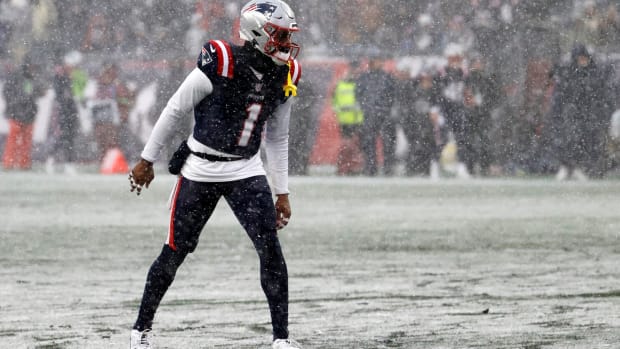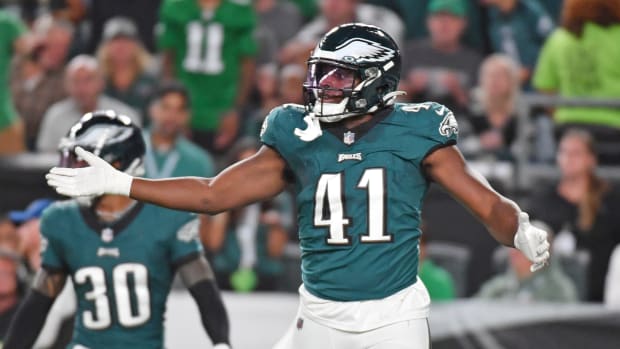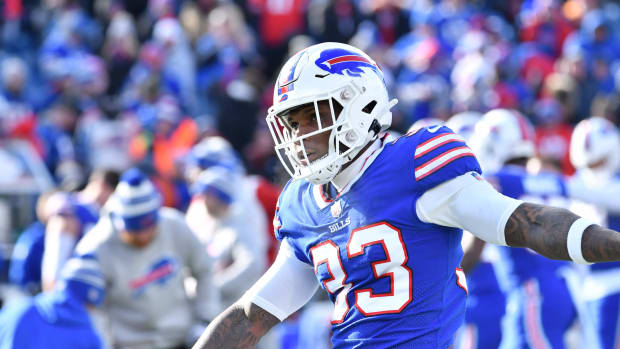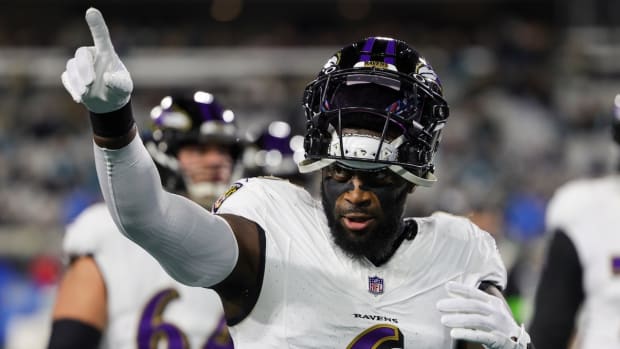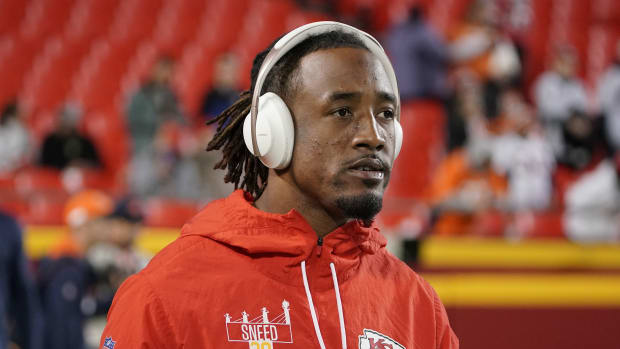
Deep Conversations
Four years ago I was pacing the sideline before a Monday night game in Washington. I spotted DeMaurice Smith, the newly elected head of the Players Association, and introduced myself. After he gave me what amounted to his opening remarks on the looming lockout, he asked where I was based. I told him Boise, and his eyes became saucers.
At that moment the crowd roared and a security guard swept in to clear everyone out. The game was starting. Smith and I never got to finish our conversation, but I know what his next question would have been. Boise, Idaho? How can you cover the NFL out of Boise, Idaho?!
Admittedly it wasn’t easy at the time. The All-22 coaches film was not available on NFL Game Rewind. That was one reason I was in D.C. to begin with; I’d made one of my biannual sojourns to NFL Films in Mt. Laurel, N.J., and was taking the opportunity to visit other East Coast football sites.
The trips to NFL Films have been career-altering, as it’s where I’ve learned to study film. When the All-22 finally became available to the public, I knew I’d never have to move away from my hometown.
To answer Smith’s (unasked) question today, I can do my job from Boise because my job is strictly to analyze football. If you know how to study coaches film (and learning how is a never-ending process), the All-22 is all you need. What happens on the field speaks for itself. I no longer leave town during the regular season, as I spend Monday through Friday studying film, and all of Sunday watching live games.
Andy on the sidelines at K.C.'s Arrowhead Stadium. (Peter King/The MMQB)
The offseason is when I do my traveling. Besides visiting NFL Films, my most rewarding trips are always to the Senior Bowl in Mobile, Ala., and the combine in Indianapolis. NFL coaching staffs are in town for those events, and I meet with coaches to talk football in-depth, off the record. I like talking to coaches more than to front-office execs, and especially more than to players, because coaches are paid to teach twentysomething-year-olds the game. I learn the most from them.
This summer a new class was added to my offseason schooling when I joined Peter King on The MMQB training camp tour.
“I think you should talk to players on this trip,” Peter told me on my first night. I’d never bothered talking to them before because, well, for starters, they’re not at any offseason functions. (The exception is the Super Bowl, where if you’re talking to players who aren’t on the competing teams you have eight minutes for a discussion, and a chunk of that time is dedicated to whatever sponsoring product the player is pitching.) Another reason I haven’t spoken with players is that it would mean attending live games during the season, where you don’t see quality replays and you spend precious hours traveling. And it’s all so that after the game a player can tell you that he just came out and tried to help his team win. (Thanks.)
“No, training camp and preseason games are different,” Peter assured me. “If you talk football with smart players, they’re going to appreciate the conversation, and you’re going to learn a lot. It will be a big developmental tool for you.”
Working on the not-so-subtle hunch that Peter is wiser about this stuff than I am, I set out to meet with a smart player from each team we visited. It didn’t take long to realize that the boss man was right.
* * *
Rob Carr/Getty Images
Andrew Luck, quarterback, Colts—Anderson, Ind., Wednesday late morning
Tell me about the wild-card-winning, 64-yard touchdown to T.Y. Hilton. It’s after the morning walk-through, and Luck and I are talking in the parking lot, about 15 cars over from where he’s just finished his press conference.
Mobile Quarterbacks
Andy Benoit's film study breakdown of the NFL's new class of mobile QBs: Luck, Wilson, Kaepernick, Newton and Griffin. Who rates as the best when it comes to using his legs? FULL STORY
“You just see a flat-footed safety, you realize it’s hard for him to turn and get speed,” Luck says, referring to Kendrick Lewis, the Chiefs free safety who was torched on the play. Lewis was in quarters coverage, meaning he was responsible for whomever attacked downfield along the outer part of the left seam. To exploit this, the Colts put their fastest player, Hilton, in the slot, where he’d have an unimpeded release off the line of scrimmage. That meant Hilton would be at full speed upon reaching Lewis, who was aligned deep.
Luck and Hilton both recognized this. “The old saying is, ‘If he’s even, he’s leavin’,’ ’’ Luck says. Hilton got even. “He knew the ball was coming to him.”
Here’s the twist: The play design did not include Hilton in Luck’s progressions. It was structured for tight end Coby Fleener to catch a deep corner on the three-receiver side. Hilton was essentially running a clear-out pattern. “But if things get busted, he’s always alive,” Luck says. “And we’d sort of given each other the Hey, be ready look.”
That’s the evolution of a great quarterback: recognizing before the snap that the alignment has created a mismatch outside the structure of the play design. Fleener did indeed get open; Luck could have very well gone there, picked up about 20 yards into Chiefs territory, and been right. But instead of taking the good play, Luck faked ever so slightly to that side, causing Lewis to react. From there, he made the great play.
MORE LUCK: Andy Benoit has this week's Sports Illustrated cover story on the Colts QB. Subscribe here.
* * *
Eric Berry, strong safety, Chiefs—Kansas City, Mo., Thursday night
Peter G. Aiken/Getty Images
The latest defensive trend is playing a three-corner, three-safety dime package, with one of those safeties lining up in a linebacker spot. It’s a great response to the flexible two-tight end and three-receiver personnel that has come to define most offenses.
There’s no better dime linebacking safety than Berry. “To be honest, it was a tough transition, moving from playing deep back to playing up close to the line,” he tells me. We’re standing in a hallway outside the Chiefs’ locker room following a preseason game against the Bengals, which Berry sat out. “You have to think a little bit faster down there because everything happens so much quicker.”
Pressed for specifics, he elaborates. “Playing down there, you can’t read stems too well.” (A “stem” is the initial part of a route, during which the receiver runs straight upfield before cutting.) “At linebacker it’s hard to read a tight end or a wide receiver stem. At a true safety position, you might be seven to ten yards deep, [so you can see everything] and buy time. You have dropping [defenders] in front of you taking up zones. But down there at linebacker, you are the zone-dropper. It’s hard to adjust to the vision.”
This is to say nothing about playing the run, something Berry, who studied Charles Woodson’s days in Green Bay, does deftly thanks to tremendous finesse.
Big run-blocking linemen can pose problems for a 6-foot, 210-pound safety, though perhaps not as much as big tight ends in the passing game. From his dime ’backer spot—and even as a strong safety in a lot of Kansas City’s base 3-4 concepts—Berry often matches up man-to-man against tight ends. It’s an area in which he struggled two years ago, but last season he thrived. Why?
“I have a homeboy, Roy Spencer, who helped me out a lot.” Spencer, who grew up with Berry in Georgia, is 6-foot-8 and played professional basketball in Italy last year. “We’ve been working on different jump-ball situations, different routes. Working on facing a big body because I’m 6-feet, most tight ends are 6-6, 6-7.”
Jimmy Graham, Tony Gonzalez, Julius Thomas, Antonio Gates… a lot of tight ends already have basketball skills of their own. Berry has learned to fight fire with fire.
“The biggest thing is patience,” he says. “They’re bigger guys, they’re not going to be as quick. I’m so antsy, I had to really work on my patience. So when they do make a move, I must be sure of that move and trust my quickness to get there. You have to choose when you actually want to go for the ball. Sometimes you might let them catch it and try to punch it out. Because you’re not always going to jump with them. It’s just taking that risk and trusting your hands to knock it out after they catch the ball. Sometimes you have to pick your battles.”
* * *
Matt Forte, running back, Bears—Chicago, Friday night
Jonathan Daniel/Getty Images
I catch Forte just as he’s heading out of the locker room after a hard—O.K., fairly easy—night’s work in the preseason opener against Philly. I’d heard somewhere that, before the arrival of head coach Marc Trestman and offensive coordinator Aaron Kromer (one of the most respected blocking instructors in the league), Forte had never actually been taught proper blocking technique or recognition. I can’t imagine this, and I want to find out if it’s true.
It is, more or less. “This staff has taught me to keep my hands inside of a defender,” Forte says. He talks about how doing so provides a stronger center of gravity and balance. And, it makes it easier to strike first—a crucial element of good blocking.
Early in his career Forte did not understand a lot of blitz concepts. “I knew if I was supposed to block the Mike ’backer or Will ’backer, but I didn’t understand how pass rushes tied to coverages.” An example: When a safety cheats over to a side and is aligned somewhere behind a slot corner, that’s a good sign of a slot blitz. Forte fully understands that now.
Last season Forte’s pass-blocking transformed into a strength for a Bears offense that centered first and foremost on protection. “Coach Trestman tells us all the time that the running back is like a sixth offensive lineman.”
Charlie Neibergall/AP
Mike Zimmer, head coach, Vikings—Mankato, Minn., Saturday early afternoon
After meeting with nearly 100 NFL coaches over the years, I have found that you can definitely tell when you’re talking to a head coach. They have a way of explaining things with a unique slant and uncommon clarity. Zimmer, 58 and in his first season as a head coach, is no exception.
And there is another characteristic he shares with a lot of head coaches. “I can’t tell you that,” he says pleasantly yet sternly after I ask him what specific offensive tactics concern him most when he goes to his staple double inside linebacker blitz looks.
But Zimmer does say: “The way we do [those double A-gap linebacker looks] puts stress on the offense by not giving anybody any pre-snap tips. We have the ability to bring numerous guys or drop numerous guys out of that look.”
We’re sitting in the golf cart that Zimmer drives around the campus of Minnesota State University, long-time training camp home of the Vikings, parked just behind the practice field gates. When the conversation transitions to coverage concepts, Zimmer makes some of the most fascinating points I’ve ever heard about pass defense. “If you’re a receiver, you can run a route with no one touching you as you go straight down the field. Or you can have somebody lined up right on top of you and now you have to think about beating that man inside, outside, having leverage, getting up the field—and then you’re trying to run that same route? Receivers every single time will say ‘I want free access.’ And quarterbacks will say the same thing.
“And really, with bump-and-run, if I’m a receiver and I release inside, 85% of the time it’s going to be an inside route. If I’m bumping and running you, you’ve predetermined your route to only four routes: a curl, a dig, a slant or a post. If you release outside, same concept. So [a pressing] defensive back, as soon as he clarifies the release, he’s gone from eight routes to defend to four.”
This speaks to one of the most important but overlooked aspects of coaching: play to the percentages. Coaches have to. If receivers stay inside 85% of the time when releasing inside, Zimmer teaches his guys to defend inside releases. Odds are, defenders will be correct 85% of the time. The defenders aren’t prepped much for the other 15% because there simply isn’t enough time to address the less likely threats.
* * *
John Sullivan, center, Vikings—Mankato, Minn., Saturday late afternoon
Jim Mone/AP
Quietly, the 29-year-old Sullivan has blossomed into a fine NFL center. He makes the calls and adjustments for an O-line that’s entering its third straight year healthy together. We chat after practice inside the MSU auxiliary gym, where the Vikings have retreated with heavy rain and lightning ripping through town.
Vikings offensive linemen are scheduled for a weightlifting session immediately following practice. Sullivan speaks fast, going over various protection concepts that, frankly, make your head spin when not afforded visual examples. “Everything is based off who the Mike linebacker is,” he sums up.
I ask about “T-T” stunts, where two defensive tackles criss-cross in an effort to create a pass-rushing lane. “If you see a defensive tackle come off the ball light, you have to be able to smell a rat,” Sullivan says. “We know when teams are going to run T-T stunts based on where our running back is aligned. Offenses slide their protections away from the running back’s side. So defenses are going to try to penetrate [to that side and] away from that slide.”
It’s a reminder of the most important lesson an analyst can learn: Almost nothing on a football field happens randomly.
* * *
Joe Thomas, left tackle, Browns—Berea, Ohio, Tuesday early afternoon
Mark Duncan/AP
“Step into my office,” seven-time Pro Bowler Joe Thomas says. He pulls up two big Gatorade buckets to sit on near the back corner of the end zone in the Browns’ indoor facility. The morning practice ended an hour ago, just before another summertime thunderstorm rolled through, sending everyone inside.
Thomas and I talk offensive line play, with me lobbing out theories and him either propping them up or shooting them down. We discuss how the increasing complexity of defensive fronts has led to the running game being partially replaced by the short passing game.
“On offense everybody exactly has to do the right thing and be perfect, and then maybe you get a four-yard run,” Thomas says. “On defense, all they have to do is get one guy through, or one guy on offense gets beat, and it’s going to be a negative run. With those odds, you can understand why teams want to pass more.
“Ninety percent of the backs in the NFL can’t beat a good linebacker one-on-one anyway. Whereas in the passing game, even if one defender gets free, the quarterback can make a small move and throw the ball downfield, no big deal.”
Those complex fronts often require a blitzing linebacker or defensive back to make the type of play that’s normally asked of a defensive lineman.
“The challenge with going against teams that throw the blitzes at you is trying to identify them,” Thomas says. “But the easy part is, you don’t have as many times when you’re having a one-on-one pass block with their ass-kicking defensive end. A lot of times you’re getting linebackers or cornerbacks. You’re rarely going to get beat by an inside linebacker’s blitz—as long as you identify it and are ready for it. When you get beat is when they run stunts and twists and you’re sliding the wrong way.”
Another time an offense gets beat is when one of those blitzing linebackers has a head of steam and goes up against a running back.
“Adalius Thomas made a living beating running backs,” Joe Thomas says. “But as soon as he went to New England, he was going against offensive tackles and he wasn’t getting as many sacks.”
Thomas is a guy any football nut could talk to for hours. But he’s already spent a half-hour with fans after practice and another half-hour with other reporters. He’s gone out of his way to accommodate me for this conversation. So shortly after we make our way back outside, beneath the now-cleared northeast Ohio skies, it’s time to part ways. Awaiting me is a flight back to Boise, and awaiting Thomas is more preparation for the long season ahead.








































